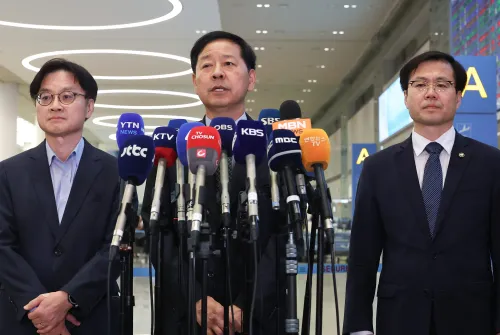What Agreements Did India and Nepal Sign for Cross-Border Power Transmission?

Synopsis
Key Takeaways
- Strengthening regional ties through energy cooperation.
- Joint ventures to improve cross-border electricity trade.
- Focus on sustainable development and energy security.
- Increased electricity capacity from Nepal to India and Bangladesh.
- Future projects aim at enhancing grid resilience.
New Delhi, Oct 29 (NationPress) India and Nepal have entered into agreements to establish two joint venture entities focused on the creation of high-capacity cross-border power transmission lines linking the two neighboring countries.
The joint venture and shareholders’ agreements were finalized here between Powergrid, a Maharatna Central public sector undertaking of India, and the Nepal Electricity Authority (NEA), with the presence of Union Power Minister Manohar Lal and Nepal’s Energy, Water Resources, and Irrigation Minister Kulman Ghising.
These agreements facilitate the formation of two joint venture entities—one in India and another in Nepal—dedicated to building cross-border power transmission infrastructure.
The planned transmission projects include the Inaruwa (Nepal)–New Purnea (India) 400 kV Double Circuit (Quad Moose) Transmission Link and the Lamki (Dododhara) (Nepal)–Bareilly (India) 400 kV Double Circuit (Quad Moose) Transmission Link.
Upon completion, these transmission corridors are expected to significantly boost electricity exchange between India and Nepal, thereby enhancing regional energy security, improving grid resilience, and fostering sustained economic growth for both nations, as stated in an official release.
The dialogue between the two ministers emphasized reinforcing the ongoing collaboration in the power sector.
Topics discussed included the advancement of hydropower projects in Nepal, along with regional grid connectivity initiatives aimed at easing cross-border electricity trade, enhancing energy security, and encouraging greater integration of clean energy resources between India and Nepal.
“The meeting today underscores the escalating momentum in India-Nepal energy collaboration, which builds upon decades of diplomatic relations and a mutual dedication to sustainable development and energy security,” the statement noted.
Moreover, NEA exports electricity to India, having commenced supplying 185 MW to Haryana on June 1, which has now increased to 200 MW. Nepal also provides electricity to Bangladesh from its 400 kV Dhalkebar Substation, which travels through Muzaffarpur and Behrampur in India before reaching Bheramara Substation in Bangladesh.









